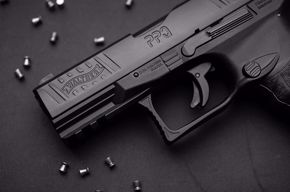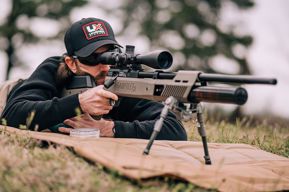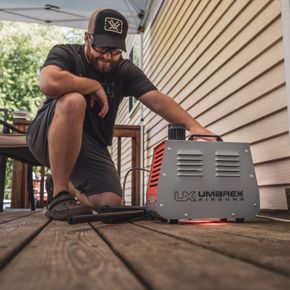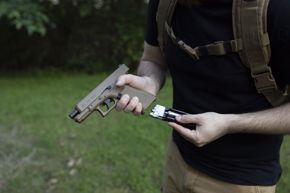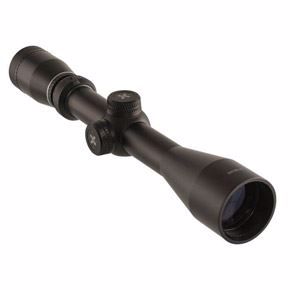The right guns in a movie or television show, especially those depicting a specific era like World War II, are essential “props” that an armorer has to get right so that the cast looks the part. You wouldn’t have a WWII American soldier carrying a pistol that hadn’t been invented yet, though it has happened, more so in westerns when the eras and guns get mixed up, but there is scarcely a WWII or even post-WWII film that doesn’t have men armed with the German MP40. It is one of the most recognized sub machineguns in history, in fact we’ve seen the MP40 so often in movies that we almost don’t see it; it’s a part of the scene, as much as uniforms and dialogue.
 Original MP40s are among the more expensive and hard to acquire WWII arms because they were fully automatic weapons, and to own one today you need a Class III firearms license. But not all MP40s are in the hands of collectors. Nearly 80 years after the MP40 was developed, many are still being used in battle-torn areas throughout the world, including the Middle East. Although vastly outdated, even by 1945 when the StG 44 was introduced, the MP40 has remained a solidly reliable (when handled properly) weapon using the most common cartridge in the world, the 9x19mm. The Umarex Legends MP40 puts all of that into your hands in .177 caliber.
Original MP40s are among the more expensive and hard to acquire WWII arms because they were fully automatic weapons, and to own one today you need a Class III firearms license. But not all MP40s are in the hands of collectors. Nearly 80 years after the MP40 was developed, many are still being used in battle-torn areas throughout the world, including the Middle East. Although vastly outdated, even by 1945 when the StG 44 was introduced, the MP40 has remained a solidly reliable (when handled properly) weapon using the most common cartridge in the world, the 9x19mm. The Umarex Legends MP40 puts all of that into your hands in .177 caliber.
A Little MP40 history
From a purely military point of view, the submachine gun was an ideal weapon for use in close to medium range combat. Submachine guns like the MP40 were the best choice for building-to-building and urban combat, which was common during WWII. The MP40 was also well suited for guards and special detachments; anywhere that a rifle would be less effective and more cumbersome to use, and where rapid fire was deemed necessary. The advent of the submachine gun in the latter part of WWI made it a viable tactical weapon by WWII. Among the earliest pioneers were German arms designers Theodor Bergmann and Hugo Schmeisser. Bergmann was one of the first to develop a semi-auto pistol and together with Schmeisser created the first German submachine gun in 1918. Known as the MP18.1 it became the forerunner of several models leading to the improved MP38, designed at Erma Werke in 1938, and the later MP40.
Although Schmeisser was not involved in either the MP38 or MP40 designs (the MP40 was the work of German arms designer Heinrich Vollmer), to this day the MP40 is often erroneously referred to as a Schmeisser. One reason for that is that Hugo Schmeisser did in fact design the MP40-based MP41, which was a wooden shoulder stocked variation with a selective fire mechanism. The use of wooden stocks, however, was not seen as an advantage due to increased weight and overall length, and models like the MP38 and MP40 used a lightweight skeletonized folding metal shoulder stock.
The MP40’s origins
 The Maschinenpistole 40 or MP40 was Vollmer’s reworked version of the MP38 and was designed to be less expensive and time consuming to manufacture for wartime use. Its pioneering construction relied more on welded and sheet metal stamped parts than its more precision-built MP38 predecessor, which utilized mostly machined parts. Welded and stamped parts became the foundation for many later military weapons, including the Uzi, which uses a similar manufacturing technique. The construction of the MP40 also used Bakelite, an earlier form of molded plastic for the pistol grips and the foregrip covering the lower receiver. Bakelite varied in color from reddish to browns and black, depending upon the manufacturer.
The Maschinenpistole 40 or MP40 was Vollmer’s reworked version of the MP38 and was designed to be less expensive and time consuming to manufacture for wartime use. Its pioneering construction relied more on welded and sheet metal stamped parts than its more precision-built MP38 predecessor, which utilized mostly machined parts. Welded and stamped parts became the foundation for many later military weapons, including the Uzi, which uses a similar manufacturing technique. The construction of the MP40 also used Bakelite, an earlier form of molded plastic for the pistol grips and the foregrip covering the lower receiver. Bakelite varied in color from reddish to browns and black, depending upon the manufacturer.
With the receiver and magazine at the front half of the MP40, the gun’s weight distribution is almost 50/50 (with an empty magazine) and the MP40 balances well with recoil minimized to some degree during shouldered burst fire. Interestingly, this portion of the MP40’s design, with the vertical magazine, is based almost entirely on Hugo Schmeisser’s MP18.1, so there is more than a little Schmeisser in the MP40! But don’t call it a Schmeisser.
If there is success in numbers, then the MP40 was a success with production reaching an estimated 1.1 million by the end of WWII. But in the world of firearms, success is also measured by longevity, not production numbers alone, many mass-produced military arms are no longer in use, many simply forgotten, while others have become collectible, but few are still in use. More than 20 nations used the MP40 for decades after WWII, some even into the early 21st century. So the MP40 has become one of the most iconic military arms in history.
To recreate the MP40 as a CO2 powered blowback action air rifle, Umarex copied the details and design of the late model version, which is quickly distinguished by the five longitudinal ribs on the side of the receiver. These were added to give soldiers a little more purchase on the gun. The shape of the receiver was such that the support hand could grasp it above the magazine. Many soldiers were prone to use the magazine itself as a forward handle, which could often lead to a jam. “Nicht die Magazine fassen!” were the words drilled into soldiers trained with the MP40. This roughly translates into “Do not grasp the magazine!” and this was an important rule for handling the gun. Hugo Schmeisser’s design for the MP18.1 receiver (which was the basis for the MP38 and MP40 receivers) left room for a firm grasp above the magazine. If the magazine itself was used as a forward grip, it could cause the magazine to move out of position and jam the gun, especially since it was always firing on full auto. This has little bearing on the Umarex Legends MP40 CO2 model, but still, if you want to shoot the gun properly, Nicht die Magazine fassen!
Measuring up
 The Umarex MP40 looks very close to the 9x19mm models but there are a few quick visual tells, particularly with the open bolt which does not travel as far back nor allow the bolt to lock up into the rear notch as a manual safety. The CO2 model’s bolt channel is shorter, although the notch for the bolt lock is still there. The other quick tell is the added selector and safety switch on the underside of the foregrip. Beyond that, at a glance the Umarex looks very much like a real 9x19mm WWII era MP40, and since the Bakelite pistol grip and foregrip of the original guns were molded plastic, the polymer pistol grip and foregrip on the Umarex look authentic enough. Making the MP40 CO2 model even more authentic in appearance is the weathered version, which costs a little more but makes up for it in capturing the look of a real WWII survivor. Preceded by the weathered finish Umarex Legends M712 and P.08 Luger Parabellum, the MP40 becomes the third leg in this unique Legends series of WWII blowback action CO2 models.
The Umarex MP40 looks very close to the 9x19mm models but there are a few quick visual tells, particularly with the open bolt which does not travel as far back nor allow the bolt to lock up into the rear notch as a manual safety. The CO2 model’s bolt channel is shorter, although the notch for the bolt lock is still there. The other quick tell is the added selector and safety switch on the underside of the foregrip. Beyond that, at a glance the Umarex looks very much like a real 9x19mm WWII era MP40, and since the Bakelite pistol grip and foregrip of the original guns were molded plastic, the polymer pistol grip and foregrip on the Umarex look authentic enough. Making the MP40 CO2 model even more authentic in appearance is the weathered version, which costs a little more but makes up for it in capturing the look of a real WWII survivor. Preceded by the weathered finish Umarex Legends M712 and P.08 Luger Parabellum, the MP40 becomes the third leg in this unique Legends series of WWII blowback action CO2 models.
In overall length, the MP40 measured 32.8 inches with the stock extended, 24.8 inches with the metal stock folded, and weighed in at 8 pounds 13.8 ounces empty. Barrel length measured 9.9 inches. The Umarex is very accurate in these details and no lightweight at 7 pounds, 14 ounces empty. The air rifle’s overall length with the stock extended is 32.75 inches and 24.5 with the stock folded. The smoothbore .177 caliber barrel is 9.0 inches and recessed inside a correct length 9.9 inch outer barrel with a full-size muzzle. Overall, more than close enough considering the number of different factories that built MP40s during WWII.
CO2 Operation
 The Umarex Legends MP40 is a ground breaking design in several ways, one of which is boosting power for this blowback action open bolt design by using a dual sealed CO2 chamber inside the magazine. It holds a pair of 12 gram CO2 cartridges, one loaded neck up and the other butt to butt with the neck down. The elongated seating screw in the base of the magazine has its own piercing pin and O-Ring seal, so when the screw is tightened down, the entire polished chamber inside the magazine is pressurized to operate the gun. A similar dual CO2 cartridge system is used in the Umarex Fusion air rifle. The factory rated velocity for the .177 caliber MP40 is 465 fps.
The Umarex Legends MP40 is a ground breaking design in several ways, one of which is boosting power for this blowback action open bolt design by using a dual sealed CO2 chamber inside the magazine. It holds a pair of 12 gram CO2 cartridges, one loaded neck up and the other butt to butt with the neck down. The elongated seating screw in the base of the magazine has its own piercing pin and O-Ring seal, so when the screw is tightened down, the entire polished chamber inside the magazine is pressurized to operate the gun. A similar dual CO2 cartridge system is used in the Umarex Fusion air rifle. The factory rated velocity for the .177 caliber MP40 is 465 fps.
After loading the CO2, the magazine is loaded by holding down the follower, inverting the magazine and pouring up to 52 steel BBs into the large loading port. Load the magazine into the receiver, pull the bolt back to chamber the first shot, and you’re ready for action.
Operation and handling
The MP40 CO2 model has the manual safety and selector discretely placed on the underside of the receiver. It is large enough to easily operate without have to search for it or turn the gun over, but still completely out of sight. The large checkered magazine release button on the left side of the receiver is pushed in firmly to release the drop free CO2 BB magazine for a reload (extra magazines are a must). The bolt on the left side needs to be pulled back to charge the gun for the first shot, after which the blowback action keeps the MP40 cycling until the magazine is empty and if you don’t learn how to feature the trigger on full auto, that’s not very long! The bolt’s reciprocating action imparts a slight sense of recoil, but has zero effect on shooting accuracy unlike the 9mm guns which only fired full auto and were hard to keep on target. The Umarex Legends and be easily switched to semi-auto. While it is not mentioned in the instruction book it is important to remember that the magazine must be loaded in order for the gun to function. If you pull the trigger on an empty magazine, all you get is a click, the action will not operate.
The sights are large, easy to pick up and get on target at 25 feet, which with the 9-inch barrel will keep rounds pretty tightly grouped on target. Trigger pull on the test gun averaged a modest 7 pounds, 5.2 ounces with 0.25 inches of travel, light stacking toward the end and a clean break. It takes a full let off to reset on semi-auto. On full auto, pull the trigger and keep the gun on target. With its overall weight, very light recoil, and barrel length, you can maintain a remarkably tight pattern with burst firing. In fact, the MP40 can keep a very tight group at a distance of up to 25 feet on full auto. At 25 feet on semi auto, the MP40 will punch groups of 10 rounds at about 1.25 inches firing from the shoulder. My best 10-shot semi-auto group measured 1.18 inches with multiple overlapping hits.
With an average factory rated velocity of 465 fps, the gun chronographed at 455 fps with a high of 460 fps, a low of 440 fps and a standard deviation for six shots of 7 fps. I managed a complete test of the MP40 on its two CO2 cartridges with all groups well under 2-inches at 25 feet, and full auto bursts measuring from 1.50 to 1.75 inches for 10 rounds. I stepped back to 25 feet on full auto and dumped 20 rounds into an IPSC silhouette target (about 2-seconds worth of ammo) and the group stayed tight with a total spread of 1.50 inches and multiple overlapping hits. (After that you need to take a breath and make sure you’re not grinning like an idiot.)
While the MP40 is strictly a military airgun enthusiast’s weapon, it is also a great CO2 airgun to shoot because of its selective fire feature, and of course, the fact that it is very costly to own a real WWII era MP40. (There is a new 9mm closed-bolt semi-automatic version made today, but not for the price of this excellent .177 caliber Umarex CO2 model).
The Takeaway
The MP40 was a stepping stone, one that came along at a very troubled time in world history. But as with all weapons, the gun has no agenda or conscience, it is the implement of its user’s intent for good or bad. The MP40 has existed long enough to have played its part on both sides of that line. As a CO2 model, it is more of a tribute to technology and firearms evolution. The MP40, like any great and enduring firearms design that has been recreated as a CO2 model today, is a part of history that we can hold in our hands.

